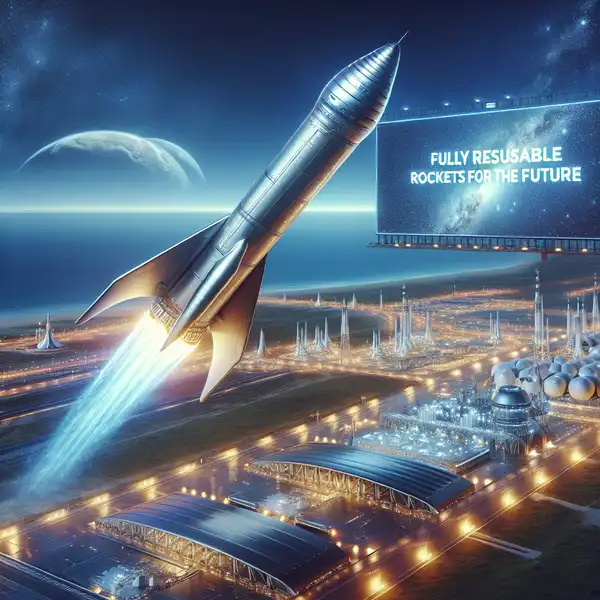
In the heart of Washington state, a small yet ambitious company is on the brink of revolutionizing the space industry. Stoke Space, co-founded by Andy Lapsa, is making significant strides towards achieving the long-sought goal of fully reusable rockets. This innovation, often referred to as the "Holy Grail of rocketry," is being meticulously developed at their new headquarters in Kent, where engineers are crafting the components of a rocket designed for repeated use.
Stoke Space is pioneering a multistage rocket that promises not only to reach orbit but also to return and relaunch with minimal downtime. The vision, as described by co-founder Tom Feldman, is to enable space travel on a schedule akin to that of commercial airlines. This approach could drastically reduce costs and enhance accessibility, potentially unlocking new commercial opportunities in space. The company plans its inaugural launch from Cape Canaveral next year, with full reusability expected to be realized a year later.
At their Moses Lake test site, Stoke Space is rigorously testing engine prototypes. This facility, set amidst the sagebrush desert, features towering fuel tanks and sophisticated test stands. The booster-stage engine is set for its first hotfire test soon, while a smaller stand is already in use for testing a unique "ring-of-fire" engine designed for the rocket's second stage. This innovative engine, described by engineer Sophia Yu as "insane," is a key component of Stoke's reusable rocket design.
Innovative Reusable Second Stage
Last year, Stoke successfully demonstrated a prototype of their second-stage engine with a hop-and-hover test at Moses Lake. This achievement marks a significant milestone in their journey towards full reusability. The company, which currently employs over 160 people, is expanding rapidly and expects to double its workforce next year. Lapsa and Feldman, who both previously worked at Blue Origin, founded Stoke in 2019, driven by a shared vision of advancing space technology.
Their journey began in Feldman's basement, where they spent months refining their engineering concepts and navigating the challenges of starting a new company. Despite the risks, their efforts have attracted substantial venture capital, enabling them to push forward with their ambitious plans.
The "Ring-of-Fire" Engine Concept
Stoke's innovative approach to rocket design includes a second-stage engine that defies traditional configurations. Unlike conventional engines with large exhaust nozzles, Stoke's design features 24 small thrusters arranged around the perimeter of a heat shield. This "ring-of-fire" configuration allows the rocket to descend vertically, with the heat shield integrated into the engine system to withstand the intense heat of reentry.
This design not only enhances reusability but also simplifies the inspection process, as the heat shield is built to be exceptionally durable. The use of cryogenic hydrogen as both fuel and coolant further optimizes the system, ensuring efficient operation even under extreme conditions.
Constructing the Rocket
At Stoke's Kent facility, the assembly of the rocket's components is in full swing. Engineers are crafting engines, heat shields, and the rocket's body, which features remarkably thin walls for its size. The manufacturing process involves cutting and forming steel sheets, as well as using advanced 3D printing techniques to produce complex parts.
The rocket's first stage will be powered by seven large engines, each capable of generating 100,000 pounds of thrust. These engines are designed to withstand temperatures up to 6,000 degrees Fahrenheit, thanks to materials like copper, inconel, and a proprietary alloy developed by Stoke.
Testing in the Desert
Stoke's test site at Moses Lake, once a barren desert, now hosts a state-of-the-art facility for engine testing. The site features a massive test stand where engines are fired vertically, with a sophisticated flame diverter system to manage the intense heat and energy. This setup allows for comprehensive testing of the engines under realistic conditions.
The company has already conducted numerous tests of their "ring-of-fire" engine, refining the design to approach flight readiness. The next iteration of this engine is currently being assembled and will undergo testing early next year.
Vision for the Future
Stoke Space is part of a growing space industry in the Pacific Northwest, which includes major players like Blue Origin and SpaceX. The region's space sector supports thousands of jobs and continues to attract talent and investment. Stoke's team is driven by a shared vision of making space travel routine and accessible, with the potential to support a wide range of commercial and scientific endeavors.
CEO Andy Lapsa envisions a future where rockets are reused as routinely as commercial aircraft, significantly lowering the cost of space access. This capability could enable new ventures such as asteroid mining, space debris cleanup, and orbital manufacturing, where the unique conditions of space offer distinct advantages.
While the idea of human colonies on Mars or the moon may seem far-fetched to some, Lapsa believes that such visions are within reach, given the right technological and economic conditions. Stoke Space aims to play a pivotal role in this future by making space travel more efficient and sustainable.
As Stoke continues to develop its technology, the company remains focused on overcoming the technical challenges ahead. With advances in materials and computing, Lapsa is confident that rapid reusability is achievable, paving the way for a new era of space exploration and innovation.